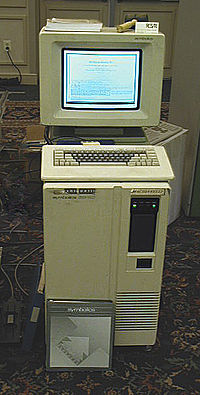
In artificial intelligence (AI), an expert system is a computer system emulating the decision-making ability of a human expert.[1] Expert systems are designed to solve complex problems by reasoning through bodies of knowledge, represented mainly as if–then rules rather than through conventional procedural programming code.[2] Expert systems were among the first truly successful forms of AI software.[3][4][5][6][7] They were created in the 1970s and then proliferated in the 1980s,[8] being then widely regarded as the future of AI — before the advent of successful artificial neural networks.[9] An expert system is divided into two subsystems: 1) a knowledge base, which represents facts and rules; and 2) an inference engine, which applies the rules to the known facts to deduce new facts, and can include explaining and debugging abilities.
- ^ Jackson, Peter (1998). Introduction To Expert Systems (3 ed.). Addison Wesley. p. 2. ISBN 978-0-201-87686-4.
- ^ "Conventional programming". Pcmag.com. Archived from the original on 2012-10-14. Retrieved 2013-09-15.
- ^ Russell, Stuart; Norvig, Peter (1995). Artificial Intelligence: A Modern Approach (PDF). Simon & Schuster. pp. 22–23. ISBN 978-0-13-103805-9. Archived from the original (PDF) on 5 May 2014. Retrieved 14 June 2014.
- ^ Luger & Stubblefield 2004, pp. 227–331.
- ^ Nilsson 1998, chpt. 17.4.
- ^ McCorduck 2004, pp. 327–335, 434–435.
- ^ Crevier 1993, pp. 145–62, 197−203.
- ^ Leondes, Cornelius T. (2002). Expert systems: the technology of knowledge management and decision making for the 21st century. pp. 1–22. ISBN 978-0-12-443880-4.
- ^ "A short history of AI". The Economist. 2024-07-16. Retrieved 2024-08-14.